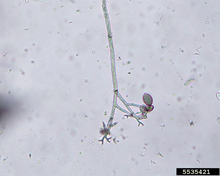Now that most of the state has gotten rain, plant diseases that have been held back by the drought are rearing up. The appearance of any disease often prompts questions about how far that disease can spread and what plants are at risk.
Most plant diseases are very host-specific
For a plant disease to show up in a garden, three things need to be present: the host plant, the disease-causing pathogen, and the right environmental conditions.
A disease can only show up in your garden if a susceptible host plant is present. The relationships between a pathogen and plants that it can make sick are often limited to one plant species or one plant family (vining vegetables, solanaceous vegetables, brassica family, etc). This means that just because your tomato plants are starting to get yellow spots and brown leaves, it doesn’t mean every vegetable plant you have is going to get sick.
Another way to think of this is in terms of other living things that get sick. Think of you and your pet. Most illnesses a dog or cat gets won’t spread to you, though there are some that can. The same is true of plant diseases. Most plant diseases are specific to one species or family of plants, though there are a couple of diseases that can impact multiple plant families.
Same name, different pathogen
Making the whole situation more complex is that there is a lot of overlap in the common names of many diseases. For many vegetables, there are diseases called downy mildew and Alternaria, but these diseases are actually caused by different (sometimes related) pathogens.
The common names of diseases (late blight, downy mildew, etc.) are easy to say and remember, but leave out some of the species-specific nuances of each pathogen and the disease it causes. There can be multiple pathogens that have the same common name, which can make things confusing very quickly.
Downy mildew is a case where we have multiple diseases with the same name. There is a disease called downy mildew in basil and in vining vegetables. Both have similar appearances, but the biology of each pathogen is completely different.
We are seeing downy mildew show up in basil. During cool, dewy times downy mildew is especially easy to identify in basil. This disease can be seedborne, and is best managed by planting resistant varieties of basil.
In vining vegetables, there is also a disease called downy mildew. This is caused by a different pathogen than the one that causes basil downy mildew. This disease is tracked by researchers and hasn’t been reported in Minnesota or a neighboring state this growing season. While downy mildew is seen in basil, it is unlikely to be seen in cucumber or pumpkins.
Another example of a common name being shared is powdery mildew. You can easily find this disease in vine crops, ornamental plants, and even weeds. While plants sick with powdery mildew have similar symptoms, it is a different pathogen causing symptoms in different plant groups. This means that the powdery mildew you see in wild grapes isn’t about to jump into your pumpkins. Your pumpkins may still get powdery mildew, but this is a reflection of cucurbit powdery mildew spores floating in the air finding the right weather conditions.
Most diseases like the same environmental conditions
The disease boom we are seeing now is the result of the right environmental conditions, as well as end-of-season plant aging. Some of the plants in the garden are reaching the end of their annual life cycles, making them extra susceptible to pathogens that the recent surge in moisture promotes.
What are the right conditions? For almost every disease, it is moisture. Why are diseases showing up in the last week? We have water again!
What’s the best way to prevent diseases from spreading? Do what we can to mitigate favorable environmental conditions, so much of which come down to moisture management. Helping leaves dry quickly (through watering technique, weeding, pruning, etc.) helps slow down disease spread.
So, how much will a disease spread?
As said above, we now have the environmental conditions for more diseases. If you are seeing the disease, the pathogen is present in your garden. How far it will spread is dependent on what the potential hosts are in your garden for that disease.
To figure out what plants can get sick you have to figure out what pathogen you are dealing with.
The first step is getting a diagnosis. For many diseases, the only way to get a solid diagnosis is via the plant disease clinic, though some diseases have very characteristic symptoms.
Once you have an idea of what the disease is, you get an idea of management tactics and how far a disease could spread. A good general practice is removing diseased leaves and entire diseased plants. More specific ways (including pesticides!) to prevent spread will depend on the disease.
How do I navigate all this complexity?
Plant diseases are hard, and plant pathologists are few. Finding diagnostic tools that work for you is key.
- The UMN offers basic and more in-depth web pages to help you understand plant disease.
- You can submit pictures to Ask a Master Gardener for help.
- If you are seeing a lot of disease on a plant you care a lot about, it may be worth it to send a plant sample into the disease clinic.




